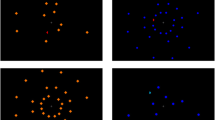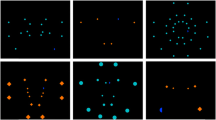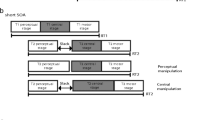Summary
Two experiments studied the effect of secondary task load on continuous visual search. Two effects were observed when a secondary task was applied. Search speed (which is assumed to reflect the efficiency of nontarget rejection) was impaired, whereas target detection distance (which presumably reflects the efficiency of target detection) increased. These findings are explained in the framework of a two-process model of visual search which assumes that two operations are performed simultaneously during each fixation, that is, automatic detection and controlled search. The secondary task interferes with the operation of controlled search which reacts to this impairment by way of a compensatory slow-down of search speed. This gain in time also benefits the operation of automatic detection which converts the temporal gain into a spatial extension of the area under its control.
Similar content being viewed by others
References
Aschersleben, G. (1982). Experiment zur Steuerung visueller Suchprozesse durch nicht-visuelle Merkmale. Unpublished manuscript, Bielefeld.
Heuer, H., & Wing, A. (1985). Doing two things at once: Process limitations and interactions. In: Smyth, M. & Wing, A. Psychology of human movement. New York: Academic Press.
Nattkemper, D., Halpaap, C., & Prinz, W. (1985). Ein Algorithmus für die Entdeckung von Sakkaden und ie Lokalisation von Fixationen in Realzeit (in preparation).
Neisser, U. (1963). Decision time without reaction time: Experiments in visual scanning. American Journal of Psychology, 76, 376–385.
Neumann, O. (1984). Automatic Processing: A review of recent findings and a plea for an old theory. In Prinz, W. & Sanders, A.F. (Eds.) Cognition and Motor Processes. Berlin, Heidelberg, New York: Springer.
Prinz, W. (1978). Auditive und artikulatorische Störbarkeit visueller Suchprozesse. Zeitschrift für Experimentelle und Angewandte Psychologie, 25, 441–455.
Prinz, W. (1979). Integration of information in visual search. Quarterly Journal of Experimental Psychology, 31, 287–304
Prinz, W. (1983a). Asymmetrical control areas in continuous visual search. In Groner, R., Menz, C., Fisher, D.F., & Monty, R.A. (Eds.) Eye Movements and Cognitive Processes. Hillsdale, N.J.: Erlbaum.
Prinz, W. (1983b). Redundanzausnutzung bei kontinuierlicher Suchtätigkeit. Psychologische Beiträge, 25, 12–56.
Prinz, W. (1984). Attention and sensitivity in visual search. Psychological Research, 45, 355–366.
Prinz, W., & Kehrer, L. (1982). Recording detection distances in continuous visual search. In Groner, R., & Fraisse, P. (Eds.) Cognition and Eye Movements. Amsterdam: North-Holland.
Scheerer, E. (1978). Expansion of the functional visual field and context skipping in a continuous search task. Psychological Research, 40, 113–126.
Author information
Authors and Affiliations
Rights and permissions
About this article
Cite this article
Prinz, W., Nattkemper, D. Effects of secondary tasks on search performance. Psychol. Res 48, 47–51 (1986). https://doi.org/10.1007/BF00309278
Received:
Issue Date:
DOI: https://doi.org/10.1007/BF00309278




